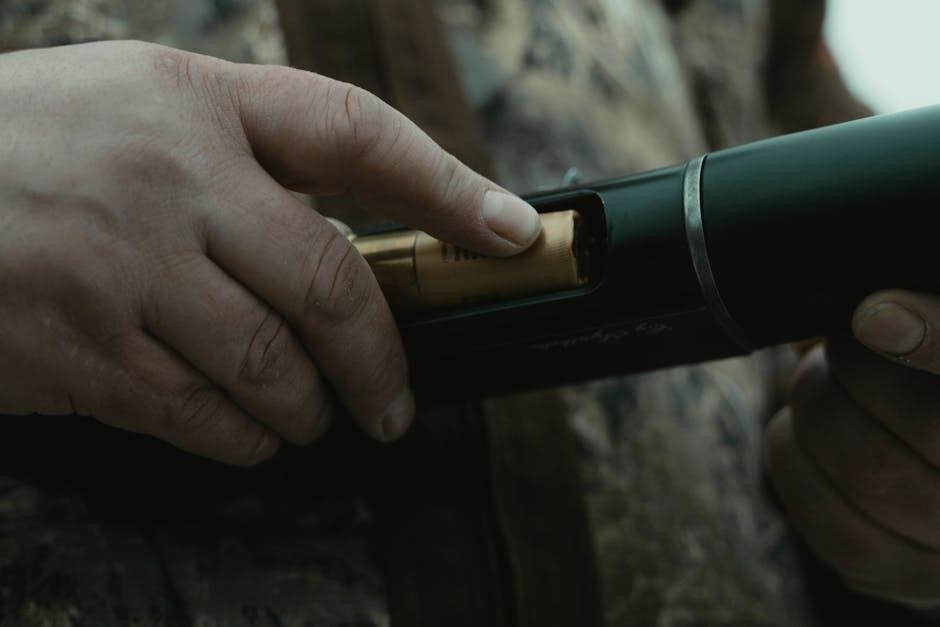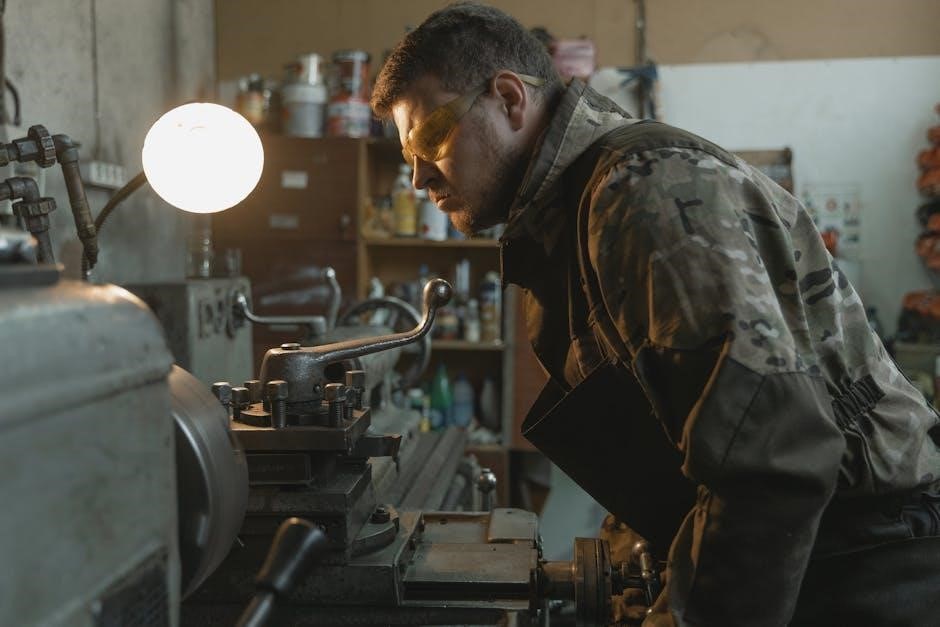Manual safety pistols are firearms featuring a mechanical safety mechanism requiring manual engagement to prevent accidental discharge, enhancing control and safety for users.
Definition and Purpose
A manual safety pistol is a firearm with a mechanical safety mechanism that must be manually disengaged to fire, preventing accidental discharge. This feature provides an extra layer of control and security, especially in high-stress situations or when carrying a loaded weapon. The primary purpose is to ensure the pistol fires only when intentionally activated, offering peace of mind for users, particularly in competitive shooting, law enforcement, and concealed carry, ensuring user safety.
Historical Background
Manual safety mechanisms on pistols emerged in the late 19th century as firearms evolved to meet safety needs. Early designs, such as the Colt 1911, introduced thumb safeties to prevent accidental discharges. Over time, these safeties became standard in military and law enforcement firearms due to their reliability. The Beretta 92, for instance, popularized the use of manual safeties in the 20th century. Historical developments reflect a focus on improving safety without compromising functionality, shaping modern pistol designs that prioritize user control and security.

Design and Mechanism
Manual safety pistols feature a mechanical mechanism that prevents trigger movement unless disengaged. Typically thumb-activated, these safeties are strategically placed for easy access during operation.
How Manual Safeties Work
Manual safeties function by physically blocking the pistol’s trigger or hammer mechanism, preventing accidental discharge. Engaging the safety typically involves a deliberate thumb or lever action, ensuring intentional control. When activated, the safety inhibits the trigger’s movement, stopping the firing process. Disengaging the safety releases these blocks, allowing the pistol to fire. This intentional design minimizes the risk of unintentional discharge, providing an additional layer of security. The mechanism is straightforward, requiring a conscious action to enable or disable, thus enhancing overall firearm safety and user responsibility.
Types of Manual Safeties
Manual safeties vary in design, with common types including thumb safeties, located on the frame, and grip safeties, which deactivate when the pistol is held firmly. Some pistols feature trigger safeties, preventing accidental pulls. Lever safeties, often on older models, require manual flipping. Automatic safeties engage when the pistol is holstered or not in use. Each type offers unique benefits, catering to different user preferences and operational needs, ensuring safe handling and intentional discharge control.
Pros and Cons
Manual safety pistols offer enhanced control and safety but require deliberate engagement, potentially slowing response times. They suit experienced users but may confuse newcomers.
Advantages of Manual Safeties
Manual safeties provide an additional layer of security, reducing the risk of accidental discharges. They are particularly beneficial in high-stress situations, offering a clear visual indicator of the firearm’s status. This feature promotes better trigger discipline and safe handling practices. Many users appreciate the tactile feedback and peace of mind that comes with a manual safety. Additionally, they are often preferred in competitive shooting sports, as they allow for precise control. Overall, manual safeties cater to both novice and experienced shooters, enhancing safety without compromising functionality.
Disadvantages of Manual Safeties
Manual safeties can introduce complexity, requiring deliberate action to engage or disengage, which may delay response times in critical situations. They rely on user compliance, as forgetting to disengage the safety can prevent the pistol from firing when needed. Additionally, manual safeties may not prevent all accidental discharges, especially if the trigger is inadvertently pulled. Some shooters find the mechanism cumbersome, especially in high-stress scenarios. Furthermore, not all users are trained to handle manual safeties effectively, potentially leading to misuse. These factors highlight the importance of proper training and situational awareness when relying on manual safeties.
Safety Best Practices
Always engage the safety when not actively firing, ensure proper trigger discipline, and use a holster to prevent accidental discharges. Regular maintenance and training are essential.
Proper Handling and Engagement
Proper handling of manual safety pistols involves ensuring the safety is engaged when not in use, keeping fingers away from the trigger, and using a secure holster. Always handle the pistol with a firm grip, ensuring the safety mechanism is intuitively accessible. Engagement should be deliberate, with a clear understanding of when to activate or deactivate the safety. Training is crucial to develop muscle memory for safe operations. Regular practice ensures smooth, safe handling during critical situations. Consistency in these practices minimizes risks and enhances overall firearm safety.

Legal and Regulatory Considerations
Manual safety pistols are subject to firearm safety laws, requiring owners to adhere to regulations ensuring secure storage and responsible use to prevent accidents and misuse.
Firearm Safety Laws and Regulations
Firearm safety laws and regulations play a crucial role in ensuring the responsible use of manual safety pistols. These laws often mandate safe storage practices, such as using locking devices or gun safes, to prevent unauthorized access. Many jurisdictions require firearm owners to complete safety training courses before obtaining a permit. Additionally, regulations may enforce penalties for negligent discharge or improper handling of firearms. These measures aim to reduce accidental injuries and deaths while promoting a culture of safety and accountability among gun owners. Compliance with these laws is essential for legal firearm ownership and public safety.

Market Trends and Popularity
Manual safety pistols remain popular, with models like the 1911 and Beretta 92 in high demand, reflecting a steady market preference for reliability and classic design.
Current Market Trends
Manual safety pistols continue to hold a significant market presence, with popular models like the 1911 and Beretta 92 remaining in high demand. Many manufacturers now offer both options: manual safety or no manual safety, catering to diverse preferences. The trend leans toward blending traditional designs with modern materials, such as lightweight polymers or stainless steel frames. Customization options, including interchangeable safeties, are also gaining traction. Despite the rise of striker-fired pistols without manual safeties, many shooters still prefer the tactile reassurance of a manual safety. This duality reflects the evolving needs of both recreational and professional users, ensuring manual safety pistols remain relevant in the market.
Maintenance and Care
Regular cleaning, lubrication, and inspection of manual safety pistols ensure optimal performance and longevity, with special attention to the safety mechanism to maintain reliable function.
Maintenance Tips for Manual Safety Pistols
Proper maintenance of manual safety pistols is crucial for reliability and safety. Regularly clean the firearm, paying attention to the barrel, slide, and frame. Use a high-quality gun lubricant to prevent friction and corrosion. Inspect the safety mechanism for wear or damage, ensuring it engages and disengages smoothly. Store the pistol in a dry, secure location, preferably in a holster or case. Test the safety periodically to confirm it functions correctly. Avoid using excessive force on the safety lever, as this can damage the internal components. Keep the pistol free from debris and grime to maintain optimal performance.
Training Requirements
Proper training for manual safety pistols involves understanding their mechanics, safe handling, and correct use of the safety mechanism. Practice under supervision is essential.
Necessary Training for Manual Safety Pistols
Training for manual safety pistols must emphasize safe handling practices, including proper engagement and disengagement of the safety mechanism. Users should understand the firearm’s design and functionality. Regular practice under qualified supervision is crucial to ensure proficiency and confidence. Instruction should cover loading, unloading, and emergency procedures to minimize risks. Additionally, training programs often include live-fire exercises to simulate real-world scenarios, reinforcing muscle memory and decision-making skills. Proper training ensures that manual safeties are used effectively, enhancing overall firearm safety and responsible ownership.

Future Developments
Future advancements in manual safety pistols may include integration of smart technology, enhanced ergonomics, and innovative materials for improved reliability and user safety.
Technological Advancements
Recent advancements in manual safety pistols include the integration of smart technology, such as biometric safeties and AI-driven trigger systems, enhancing security and user control. Manufacturers are also exploring ergonomic designs and lightweight materials to improve handling and durability. Additionally, innovations in safety mechanisms, like automated engagement based on grip recognition, are being developed to prevent accidental discharges. These technological strides aim to balance safety, functionality, and user convenience, making manual safety pistols more adaptable to modern needs while maintaining their reliability in critical situations.
Comparisons with Other Safety Mechanisms
Manual safeties differ from automatic mechanisms by requiring intentional engagement, offering a physical control point for users to manage firearm operation intentionally and deliberately.
Manual vs. Automatic Safeties
Manual safeties require deliberate engagement by the user, offering a clear physical control point, while automatic safeties activate without user input, relying on trigger or grip mechanics. Manual safeties, like those on the 1911, provide an extra layer of security but may slow draw times. Automatic safeties, as seen on Glock pistols, prioritize quick access and ease of use. Both designs aim to prevent accidental discharges but cater to different preferences and scenarios. The choice often depends on the shooter’s training, environment, and intended use, with manual safeties appealing to traditionalists and automatic safeties favored for simplicity and speed.
Case Studies and Notable Incidents
Manual safety pistols, like the 1911, have been involved in high-profile incidents, showcasing their reliability and safety features in critical situations, while also highlighting user training importance;
Real-World Applications and Lessons Learned
Manual safety pistols, such as the 1911 and Beretta 92, are widely used in law enforcement and military contexts due to their reliability and safety features. In real-world scenarios, these pistols have proven effective in preventing accidental discharges, especially in high-stress situations. However, incidents have also highlighted the importance of proper training to ensure users can quickly engage or disengage the safety mechanism when necessary. Lessons learned emphasize that while manual safeties add a layer of security, they require consistent practice to avoid delays in critical moments.
Manual safety pistols remain a vital option for firearm users, offering an additional layer of security and control; Their proven reliability in law enforcement and military contexts underscores their practical value. However, the debate over their necessity in modern designs continues, as some prioritize streamlined operation without manual safeties. Proper training and adherence to safety protocols are essential for their effective use. As firearm technology evolves, the role of manual safeties may adapt, but their historical significance and continued popularity highlight their enduring relevance in the world of handguns.
